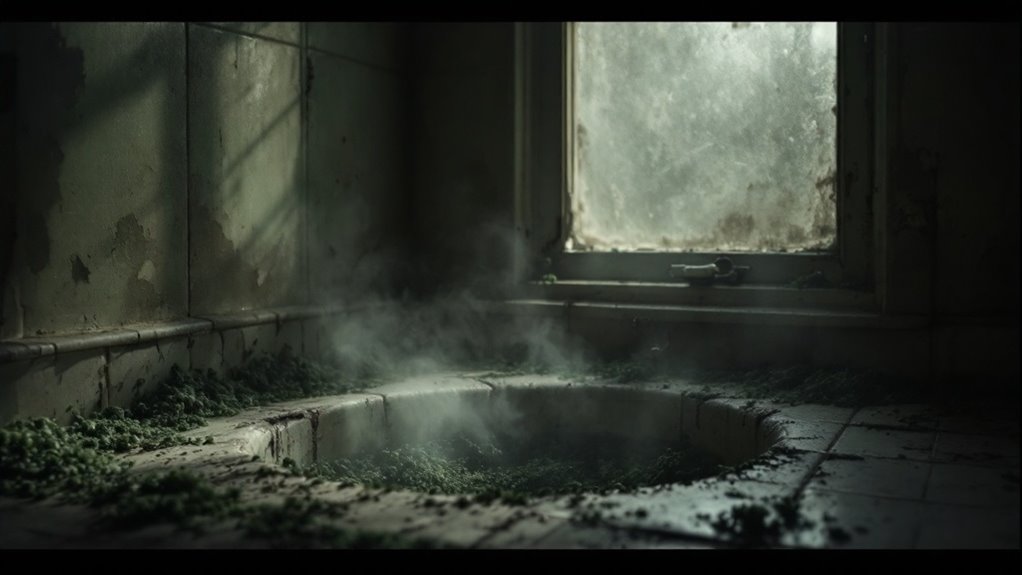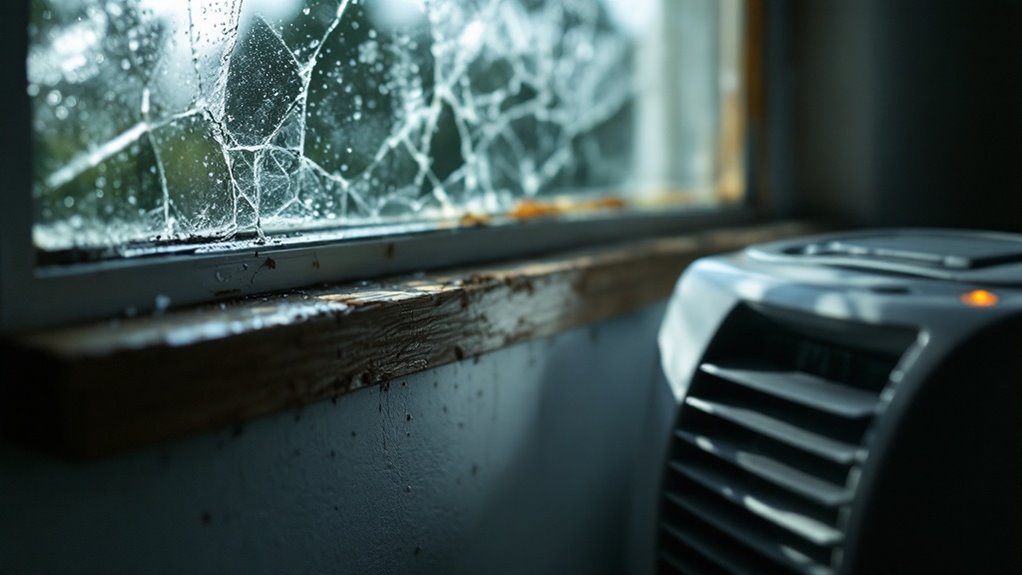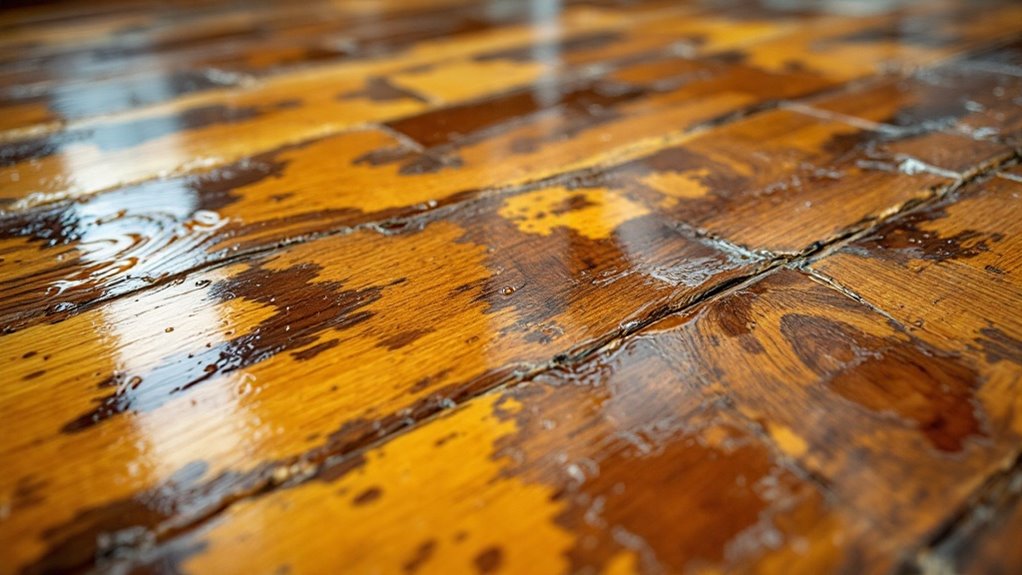You might not see mold, but that doesn’t mean it’s not lurking in your home. Hidden mold can cause serious health issues and structural damage. Unexplained musty odors or unusual stains on your walls could be warning signs. If you think everything looks fine, you might want to reconsider. Uncovering the subtle indicators of mold from water damage is essential for your well-being and home safety.
Key Takeaways
- Unexplained musty odors often indicate hidden mold growth due to moisture from water damage, especially in basements and bathrooms.
- Visible water stains on walls or ceilings suggest moisture infiltration, which can lead to mold even if not immediately visible.
- Increased humidity levels in your home can signal water damage and create a conducive environment for mold growth.
- Warped or discolored surfaces, like buckled flooring or stained drywall, often hint at underlying moisture issues and potential mold presence.
- Regular condensation on windows and walls may indicate poor ventilation, which can contribute to hidden mold growth from water damage.
Unexplained Musty Odors

One of the most common signs of mold due to water damage is an unexplained musty odor. If you notice this smell in your home, it’s a clear indication that moisture has created an environment for mold to thrive. You might detect it in areas like basements, bathrooms, or near leaks. It’s crucial to trust your senses; that musty scent often means mold is present, even though you can’t see it. Ignoring the smell can lead to larger issues, including health problems and structural damage. To address this, investigate the source of moisture and consider professional help for mold remediation. Taking action early can save you time, money, and potential health risks down the line. Additionally, a comprehensive mold inspection can help identify hidden mold and moisture issues that may not be immediately visible.
Visible Water Stains
If you spot visible water stains on your walls or ceilings, it’s a strong indicator that moisture has infiltrated your home, potentially leading to mold growth. These stains often appear as dark patches or discoloration, and they can vary in size. Pay close attention to areas around windows, pipes, or roofs, as these are common sources of leaks. Even though the stains seem dry, they can still indicate underlying moisture issues, which are prime conditions for mold to thrive. It’s important to address the source of the water intrusion and repair any damage. Ignoring these stains may lead to more severe problems down the line, including health risks associated with mold exposure. Additionally, moisture accumulation can significantly exacerbate mold growth, making it crucial to stay vigilant and act promptly!
Increased Humidity Levels

When you notice increased humidity levels in your home, it’s essential to measure them accurately using humidity measurement tools. High humidity can stem from various sources, like leaks or poor ventilation. Understanding these factors can help you tackle the problem before mold takes hold. Additionally, regular home inspections are vital for identifying potential issues early, which can prevent further complications related to humidity and mold growth.
Humidity Measurement Tools
To effectively assess increased humidity levels in your home, utilizing humidity measurement tools is essential. These tools help you monitor and manage moisture, which is important in preventing mold growth. Here are three common humidity measurement tools you should consider:
- Hygrometer: This device accurately measures the humidity levels in your space, allowing you to take action if levels rise.
- Digital Thermohygrometer: Combining temperature and humidity readings, this tool provides an extensive view of your environment.
- Smart Home Sensors: These devices can send alerts to your phone when humidity levels reach a certain threshold, keeping you informed even when you’re away.
Causes of High Humidity
Monitoring humidity levels is crucial for maintaining a healthy home environment, but knowing what causes high humidity is just as important. High humidity often stems from common household activities. Cooking, showering, and even breathing release moisture into the air. Poor ventilation can trap this humidity indoors, especially in bathrooms and kitchens. Weather conditions play a role too; living in a humid climate or experiencing heavy rain can raise indoor moisture levels. Furthermore, leaks from roofs, windows, or plumbing can introduce unwanted water. If your home lacks proper insulation, it might likewise struggle to regulate humidity. By understanding these causes, you can take steps to manage humidity effectively and prevent potential mold growth.
Allergic Reactions and Respiratory Issues
Although you might not see mold right away, its presence can lead to significant allergic reactions and respiratory issues. If you’re experiencing symptoms, it’s essential to pay attention. Common signs include:
- Sneezing and runny nose: These can indicate your body’s reaction to mold spores in the air.
- Coughing or wheezing: Persistent coughing can signal irritation in your airways because of mold exposure.
- Skin rashes or irritation: You might develop rashes when you come into contact with mold.
If you notice these symptoms, consider evaluating your environment for hidden mold. Addressing mold issues early can help you breathe easier and improve your overall health. Don’t ignore these signs; your well-being depends on it.
Warped or Discolored Surfaces

Mold can not only trigger allergic reactions and respiratory issues but likewise manifest visibly as warped or discolored surfaces in your home. If you notice floors, walls, or ceilings that look uneven or stained, it might be a sign of hidden moisture and mold growth.
| Surface Type | Signs of Warping or Discoloration | Potential Causes |
|---|---|---|
| Wood Flooring | Buckled, cupped, or sagging | Excess humidity, leaks |
| Drywall | Yellow or brown stains | Water intrusion, high moisture |
| Ceiling Tiles | Sagging or stained areas | Roof leaks, condensation |
| Baseboards | Peeling or discoloration | Flooding, high humidity |
Addressing these issues promptly can help prevent further damage and guarantee a healthier living environment.
Peeling Paint or Wallpaper
When you see peeling paint or wallpaper, it’s often a clear sign of moisture issues that could be linked to mold growth. This damage happens when excess humidity seeps beneath the surface, causing the materials to lose their adhesion. Ignoring this issue can lead to serious mold problems, so it’s important to investigate further.
Consider these key points:
- Source of Moisture: Check for leaks or water intrusion that may be causing the peeling.
- Ventilation: Poor airflow can trap humidity, exacerbating the problem.
- Extent of Damage: If peeling is widespread, there’s likely a more significant issue at play.
Addressing these factors can help prevent mold and preserve the integrity of your walls.
Persistent Condensation on Windows
If you notice persistent condensation on your windows, it’s a sign of excessive humidity levels in your home. This moisture often indicates poor ventilation, which can create an ideal environment for mold growth. Keeping an eye on these signs can help you address potential water damage before it worsens.
Excessive Humidity Levels
Excessive humidity levels often manifest as persistent condensation on your windows, signaling a potential problem in your home. This moisture not only affects your comfort but can likewise lead to mold growth if left unchecked. Here are a few signs that confirm excessive humidity:
- Frequent fogging: Windows constantly fog up, especially in colder months.
- Musty odors: You might notice a damp smell, even in dry areas.
- Warped wood: Signs of swelling or warping in wooden furniture or floors can indicate high moisture levels.
Addressing these issues promptly can help maintain a healthy environment. Consider using a dehumidifier or improving your home’s insulation to rectify excessive humidity and prevent mold growth.
Poor Ventilation Issues
While you might not think much about it, poor ventilation can lead to persistent condensation on your windows, highlighting a serious issue in your home. When warm air meets the cold surface of your windows, moisture accumulates, creating an ideal environment for mold growth. If you notice this condensation regularly, it’s a sign that your home isn’t breathing properly.
You should check for blocked vents, closed windows, or inadequate air circulation. Open your windows when possible to let fresh air in, and consider using exhaust fans in areas like the kitchen and bathroom. Addressing these ventilation issues not only helps reduce condensation but additionally minimizes the risk of mold, ensuring a healthier living space.
Conclusion
Don’t dismiss those subtle signs of mold simply due to the fact that you can’t see it. Even when your home looks fine, unexplained odors or humidity levels can indicate hidden problems that could affect your health. You might think ignoring these signs is easier, but addressing them early can save you time and money in the long run. Stay proactive by checking for moisture and taking action—your home and well-being deserve it!
